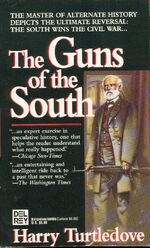
A bounding mine is an anti-personnel mine designed to be used in open areas. When tripped, a small propelling charge launches the body of the mine 3-4 feet into the air, where the main charge bursts and sprays fragmentation at roughly waist height. The original World War II German S-mine (nicknamed "Bouncing Betty") has been widely influential. Other countries that have employed bounding mines in war include the United States, Soviet Union, and Vietnam. China and Italy have also produced them. Some American mines designed for this purpose utilized a standard 60 mm HE mortar round with an improvised time delay fuze which is activated by the propelling charge.
Bounding Mine in The Guns of the South[]
The Rivington Men defended the approaches to the town of Rivington with land torpedoes. While few in number, these were effective in demoralizing Confederate troops. Major J.P. Strange, General Nathan Bedford Forrest's adjutant, was torn in half by a land torpedo when he led a company attempting to outflank Rivington Men field fortifications.[1]
Bounding Mine in Southern Victory[]
The Popping Paula was an anti-personal mine used by the Confederate Army during the last days of 1942 against the U.S. Army which had encircled the Confederates in Pittsburgh. Dr. Leonard O'Doull and Sgt. Granville McDougald both treated a young soldier who had his groin injured by a blast from a Popping Paula, prompting both men to wonder why these types of mines been allowed by the Geneva Convention.[2]
Throughout the rest of the war, they were the preferable type of mine of the CS Army, and used right up until the surrender in 1944.
References[]
- ↑ The Guns of the South, pgs. 517-522, mmp.
- ↑ Drive to the East, pg. 577, hc.
| |||||||||||||||||||











